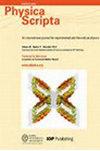基于改进的布昂尼奥尔诺方法的涉及赖纳-里夫林纳米流体的博德瓦特滑移流动动力学回归建模
IF 2.6
3区 物理与天体物理
Q2 PHYSICS, MULTIDISCIPLINARY
引用次数: 0
摘要
回归模型可准确预测壁面剪切力和传热系数,因此在分析旋转流时非常有用。此外,在涡轮机械和地球物理流等旋转系统的流体动力学中,伯德瓦特流具有极其重要的意义。此外,纳米流体增强的传热性能可以提高涡轮机和电子系统应用中的冷却效率。本研究深入探讨了在滑移条件下,含有纳米颗粒的 Reiner-Rivlin 流体在静止多孔盘上的 Bödewadt 边界层流动。研究采用了两相 Buongiorno 模型,并加入了随温度变化的扩散系数,以提高精确度。为便于进行数值模拟,传输方程被转换为包含四个未知数的常微分系统。本研究采用了高度可靠的 Keller-Box 方法,该方法与 MATLAB 内置程序 "bvp4c "非常吻合。计算出的二维和三维流线生动地捕捉到了使用 Reiner-Rivlin 纳米流体的 Bödewadt 流动场景。其原理旨在研究非牛顿行为和滑移对流动模式的影响,同时还考察了纳米粒子工作流体的温度/浓度场行为。随着热泳扩散的增加,热边界层明显变厚,导致圆盘冷却速度明显下降。相比之下,布朗扩散对热传输的影响微乎其微。此外,还观察到壁吸效应显著提高了圆盘的冷却速率,不过这取决于表皮摩擦系数的增加。本研究引入了线性和二次回归模型,旨在精确预测表面阻力和圆盘冷却速率,这两个因素在工程过程中至关重要。本文章由计算机程序翻译,如有差异,请以英文原文为准。
Regression modeling of Bödewadt slip flow dynamics involving Reiner-Rivlin nanofluid based on a modified Buongiorno approach
Regression models are useful in analyzing rotational flows as they enable accurate predictions of wall shear and heat transfer coefficient. In addition, Bödewadt flow is of paramount importance in fluid dynamics of rotating systems such as turbomachinery and geophysical flows. Moreover, nanofluid’s enhanced heat transfer properties can improve cooling efficiency in applications involving turbines and electronic systems. This study delves into the Bödewadt boundary layer flow of a Reiner-Rivlin fluid containing nanoparticles over a stationary porous disk under slip conditions. The two-phase Buongiorno model is employed, incorporating temperature-dependent diffusion coefficients for enhanced accuracy. To facilitate numerical simulations, the transport equations are converted into an ordinary differential system comprising four unknowns. In the present work, a highly reliable Keller-Box methodology is adopted which agrees very well with the MATLAB built-in program ‘bvp4c’. The computed 2-D and 3-D streamlines vividly capture the Bödewadt flow scenario with Reiner-Rivlin nanofluid. The principle aim to investigate the impact of non-Newtonian behaviour and slip on the flow pattern, while also examining the behavior of temperature/concentration field for nanoparticle working fluids. As thermophoretic diffusion increases, the thermal boundary layer thickens considerably, leading to a notable decrease in the cooling rate of the disk. In contrast, Brownian diffusion has only a minimal impact on the heat transport. In addition, wall suction effect is observed to significantly boost the disk’s cooling rate, though at the expanse of increasing skin friction coefficients. This study introduces linear and quadratic regression models designed to precisely predict both the surface drag and disk cooling rate, which are crucial factors in engineering processes.
求助全文
通过发布文献求助,成功后即可免费获取论文全文。
去求助
来源期刊

Physica Scripta
物理-物理:综合
CiteScore
3.70
自引率
3.40%
发文量
782
审稿时长
4.5 months
期刊介绍:
Physica Scripta is an international journal for original research in any branch of experimental and theoretical physics. Articles will be considered in any of the following topics, and interdisciplinary topics involving physics are also welcomed:
-Atomic, molecular and optical physics-
Plasma physics-
Condensed matter physics-
Mathematical physics-
Astrophysics-
High energy physics-
Nuclear physics-
Nonlinear physics.
The journal aims to increase the visibility and accessibility of research to the wider physical sciences community. Articles on topics of broad interest are encouraged and submissions in more specialist fields should endeavour to include reference to the wider context of their research in the introduction.
 求助内容:
求助内容: 应助结果提醒方式:
应助结果提醒方式:


